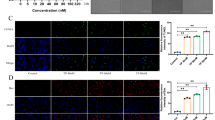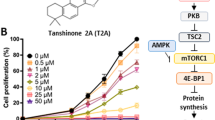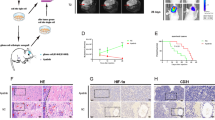Abstract
Aim:
To examine the effects of anisomycin on glioma cells and the related mechanisms in vitro.
Methods:
The U251 and U87 human glioblastoma cell lines were tested. The growth of the cells was analyzed using a CCK-8 cell viability assay. Apoptosis was detected using a flow cytometry assay. The expression of proteins and phosphorylated kinases was detected using Western blotting.
Results:
Treatment of U251 and U87 cells with anisomycin (0.01–8 μmol/L) inhibited the cell growth in time- and concentration-dependent manners (the IC50 values at 48 h were 0.233±0.021 and 0.192±0.018 μmol/L, respectively). Anisomycin (4 μmol/L) caused 21.5%±2.2% and 25.3%±3.1% of apoptosis proportion, respectively, in U251 and U87 cells. In the two cell lines, anisomycin (4 μmol/L) activated p38 MAPK and JNK, and inactivated ERK1/2. However, neither the p38 MAPK inhibitor SB203580 (10 μmol/L) nor the JNK inhibitor SP600125 (10 μmol/L) prevented anisomycin-induced cell death. On the other hand, anisomycin (4 μmol/L) reduced the level of PP2A/C subunit (catalytic subunit) in a time-dependent manner in the two cell lines. Treatment of the two cell lines with the PP2A inhibitor okadaic acid (100 nmol/L) caused marked cell death.
Conclusion:
Anisomycin induces glioma cell death via down-regulation of PP2A catalytic subunit. The regulation of PP2A/C exression by anisomycin provides a clue to further study on its role in glioma therapy.
Similar content being viewed by others
Log in or create a free account to read this content
Gain free access to this article, as well as selected content from this journal and more on nature.com
or
References
Gold PE . Protein synthesis inhibition and memory: formation vs amnesia. Neurobiol Learn Mem 2008; 89: 201–11.
Yang H, Choi HJ, Park SH, Kim JS, Moon Y . Macrophage inhibitory cytokine-1 (MIC-1) and subsequent urokinase-type plasminogen activator mediate cell death responses by ribotoxic anisomycin in HCT-116 colon cancer cells. Biochem Pharmacol 2009; 78: 1205–13.
Lunghi P, Tabilio A, Pinelli S, Valmadre G, Ridolo E, Albertini R, et al. Expression and activation of SHC/MAP kinase pathway in primary acute myeloid leukemia blasts. Hematol J 2001; 2: 70–80.
Caricchio R, D'Adamio L, Cohen PL . Fas, ceramide and serum withdrawal induce apoptosis via a common pathway in a type II Jurkat cell line. Cell Death Differ 2002; 9: 574–80.
Clerk A, Sugden PH . Cell stress-induced phosphorylation of ATF2 and c-Jun transcription factors in rat ventricular myocytes. Biochem J 1997; 325: 801–10.
Mawji IA, Simpson CD, Gronda M, Williams MA, Hurren R, Henderson CJ, et al. A chemical screen identifies anisomycin as an anoikis sensitizer that functions by decreasing FLIP protein synthesis. Cancer Res 2007; 67: 8307–15.
Piekarski DJ, Seto T, Zucker I . The protein synthesis inhibitor anisomycin reduces sex behavior during a critical period after testosterone treatment in male Syrian hamsters. Physiol Behav 2011; 105: 215–9.
Sadowski RN, Canal CE, Gold PE . Lidocaine attenuates anisomycin-induced amnesia and release of norepinephrine in the amygdala. Neurobiol Learn Mem 2011; 96: 136–42.
Malysheva MV, Grigoryev AA, Bulycheva TI, Zatsepina OV . Enhanced sensitivity of nucleoli in human proliferating cells to inhibition of protein synthesis with anisomycin. Bull Exp Biol Med 2010; 150: 258–62.
Croons V, Martinet W, Herman AG, Timmermans JP, De Meyer GR . The protein synthesis inhibitor anisomycin induces macrophage apoptosis in rabbit atherosclerotic plaques through p38 mitogen-activated protein kinase. J Pharmacol Exp Ther 2009; 329: 856–64.
Desgranges B, Levy F, Ferreira G . Anisomycin infusion in amygdala impairs consolidation of odor aversion memory. Brain Res 2008; 1236: 166–75.
Wang Q, Zhang JY, Liu SJ, Li HL . Overactivated mitogen-activated protein kinase by anisomycin induces tau hyperphosphorylation. Sheng Li Xue Bao 2008; 60: 485–91.
Qiao S, Murakami K, Zhao Q, Wang B, Seo H, Yamashita H, et al. Mimosine-induced apoptosis in C6 glioma cells requires the release of mitochondria-derived reactive oxygen species and p38, JNK activation. Neurochem Res 2012; 37: 417–27.
Junttila MR, Li SP, Westermarck J . Phosphatase-mediated crosstalk between MAPK signaling pathways in the regulation of cell survival. FASEB J 2008; 22: 954–65.
Xia Z, Dickens M, Raingeaud J, Davis RJ, Greenberg ME . Opposing effects of ERK and JNK-p38 MAP kinases on apoptosis. Science 1995; 270: 1326–31.
Frisch SM, Francis H . Disruption of epithelial cell-matrix interactions induces apoptosis. J Cell Biol 1994; 124: 619–26.
Frisch SM, Screaton RA . Anoikis mechanisms. Curr Opin Cell Biol 2001; 13: 555–62.
Mawji IA, Simpson CD, Hurren R, Gronda M, Williams MA, Filmus J, et al. Critical role for Fas-associated death domain-like interleukin-1-converting enzyme-like inhibitory protein in anoikis resistance and distant tumor formation. J Natl Cancer Inst 2007; 99: 811–22.
Frisch SM . Evidence for a function of death-receptor-related, death-domain-containing proteins in anoikis. Curr Biol 1999; 9: 1047–9.
Rosen K, Shi W, Calabretta B, Filmus J . Cell detachment triggers p38 mitogen-activated protein kinase-dependent overexpression of Fas ligand. A novel mechanism of Anoikis of intestinal epithelial cells. J Biol Chem 2002; 277: 46123–30.
Ashley DM, Riffkin CD, Muscat AM, Knight MJ, Kaye AH, Novak U, et al. Caspase 8 is absent or low in many ex vivo gliomas. Cancer 2005; 104: 1487–96.
Gotz J, Probst A, Ehler E, Hemmings B, Kues W . Delayed embryonic lethality in mice lacking protein phosphatase 2A catalytic subunit Calpha. Proc Natl Acad Sci U S A 1998; 95: 12370–5.
He X, Anderson JC, del Pozo O, Gu YQ, Tang X, Martin GB . Silencing of subfamily I of protein phosphatase 2A catalytic subunits results in activation of plant defense responses and localized cell death. Plant J 2004; 38: 563–77.
Li X, Scuderi A, Letsou A, Virshup DM . B56-associated protein phosphatase 2A is required for survival and protects from apoptosis in Drosophila melanogaster. Mol Cell Biol 2002; 22: 3674–84.
Wong LL, Zhang D, Chang CF, Koay ES . Silencing of the PP2A catalytic subunit causes HER-2/neu positive breast cancer cells to undergo apoptosis. Exp Cell Res 2010; 316: 3387–96.
Acknowledgements
We thank Professor Kun YAO for providing the U251 and U87 human glioblastoma cell line. This work was supported by grants from the Jiangsu Province Natural Science Foundation (No BK2007257).
Author information
Authors and Affiliations
Corresponding author
Rights and permissions
About this article
Cite this article
Li, Jy., Huang, Jy., Li, M. et al. Anisomycin induces glioma cell death via down-regulation of PP2A catalytic subunit in vitro. Acta Pharmacol Sin 33, 935–940 (2012). https://doi.org/10.1038/aps.2012.46
Received:
Accepted:
Published:
Issue date:
DOI: https://doi.org/10.1038/aps.2012.46
Keywords
This article is cited by
-
The mutual regulatory loop between TPTEP1 and miR-1303 in leukemogenesis of acute myeloid leukemia
Cancer Cell International (2021)
-
Combinatorial targeting of MTHFD2 and PAICS in purine synthesis as a novel therapeutic strategy
Cell Death & Disease (2019)
-
microRNA let-7c is essential for the anisomycin-elicited apoptosis in Jurkat T cells by linking JNK1/2 to AP-1/STAT1/STAT3 signaling
Scientific Reports (2016)
-
Nuclear Protein Phosphatase 1 α (PP1A) Expression is Associated with Poor Prognosis in p53 Expressing Glioblastomas
Pathology & Oncology Research (2016)
-
Phosphorylation of AKT induced by phosphorylated Hsp27 confers the apoptosis-resistance in t-AUCB-treated glioblastoma cells in vitro
Journal of Neuro-Oncology (2015)



